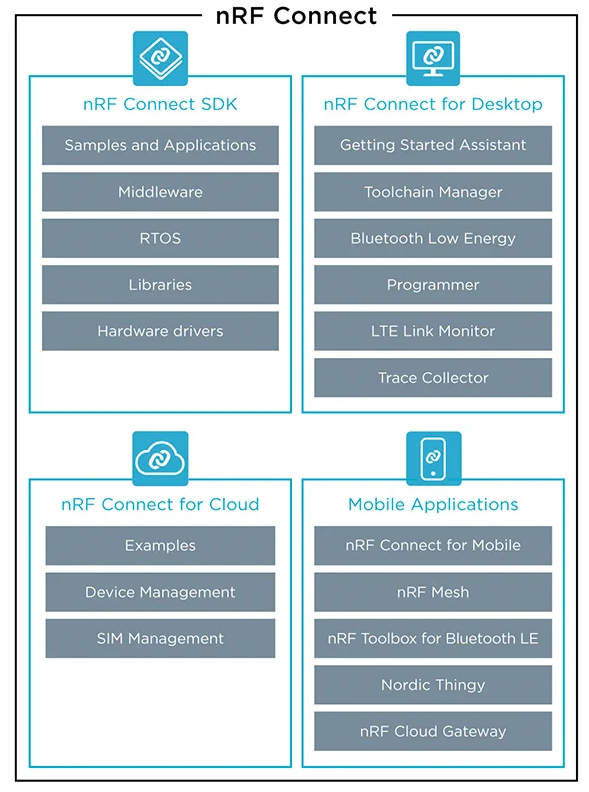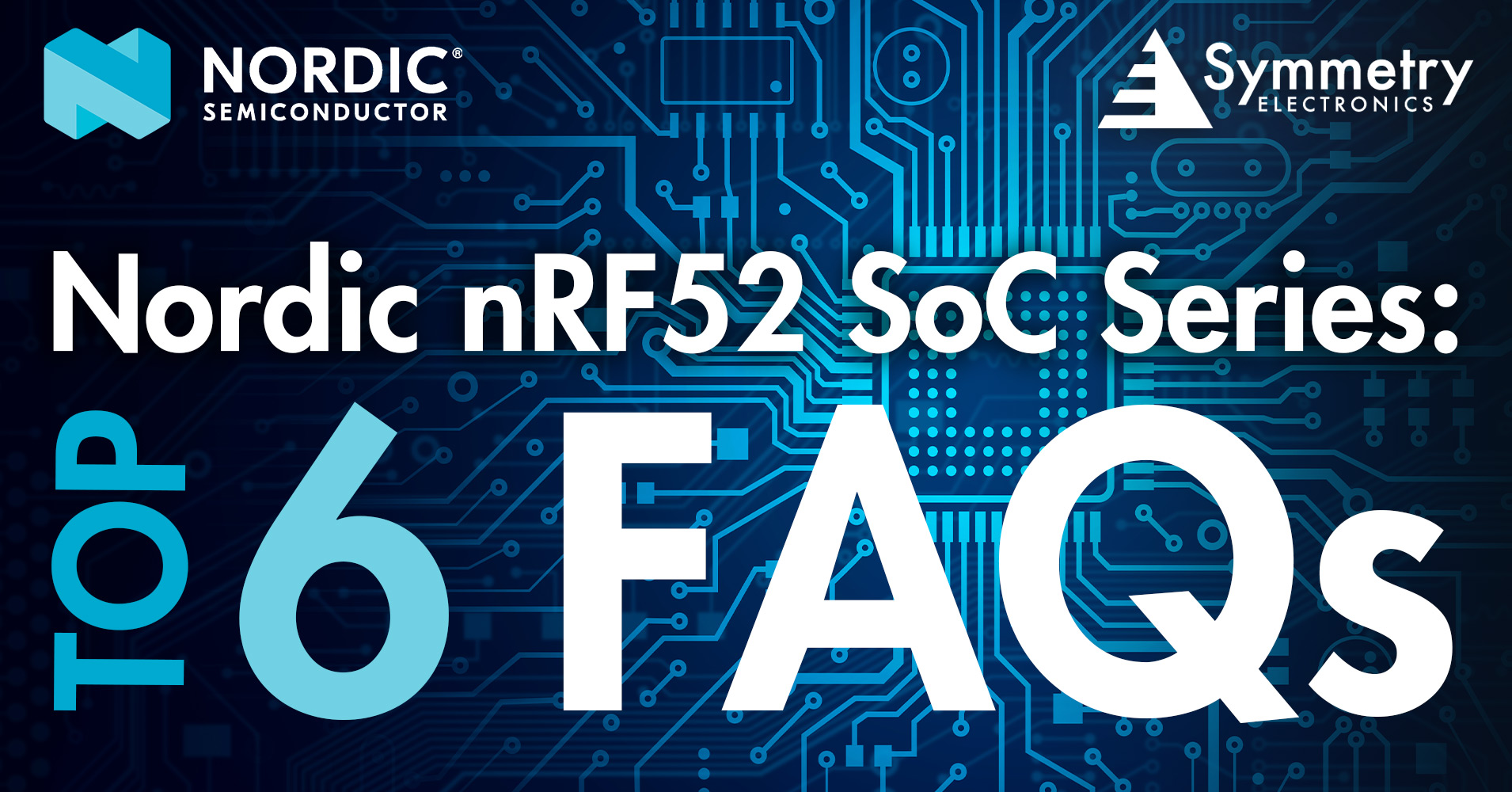- Home
- Symmetry Blog
- Nordic nRF52 SoC Series: Top 6 FAQs | Symmetry Blog
Nordic nRF52 SoC Series: Top 6 FAQs | Symmetry Blog
About Augustine Nguyen
1. What are the major differences between each of the nRF52 SoCs in the series?
The nRF52 Series is a family of SoCs that possess an ARM Cortex-M4 processor along with a 2.4GHz RF transceiver that supports Bluetooth Low Energy (BLE, BT5.0 - 5.2). What sets each of these SoC variants apart are the additional 2.4GHz protocols they can support (ANT, IEEE 802.15.4, Zigbee, Thread); specific advanced features of BLE they offer (2 Mbps, Long range, Mesh, Direction-Finding); and their memory capacity. The varying flash and RAM capacity that each of the SoCs offer, helps determine which Bluetooth features will be supported, as they correlate with the size of the protocol stack (Soft Device) that Nordic provides. Additionally, depending on the Bluetooth version that is supported, the hardware that is used will vary between each of the SoCs. For more information, see Nordic Semiconductor’s nRF52 Series comparison chart.
2. Can any of the nRF52 SoCs support audio streaming?
Bluetooth audio devices that currently exist on the market are based on Bluetooth Classic (BTv1.0 - 3.0), an older version of the wireless protocol. All of Nordic’s devices are based on the BLE specification (BTv4.0 - 5.2) and do not support the legacy versions of Bluetooth Classic (which includes their standardized audio profile (A2DP) for streaming applications). In early 2020, however, the Bluetooth SIG announced the development of LE Audio–a new generation of Bluetooth that can now support audio streaming over BLE due to its high data rates and low power performance. While Bluetooth 5.2 is the minimum version of Bluetooth Core Specifications required to enable LE Audio, Nordic is yet to release a Bluetooth 5.2 software stack to support it. Additionally, the LE Audio specification is still under development and is not expected to be released until early-mid 2021. For future consideration in using Nordic’s platform for LE Audio, the new nRF5340 is recommended, as it has higher performance to run the LC3 Audio Codec on top of the Bluetooth 5.2 stack while offering improved audio PLL.
3. What is the current support for Bluetooth direction-finding (AoA, AoD)?
The nRF52811, nRF52820, and nRF52833 SoCs support Bluetooth direction-finding features (i.e. AoA or AoD), which are at the core of the Bluetooth 5.1 specification. Nordic’s nRF52833DK evaluation board hosts the nRF52833 SoC, however, it requires an external antenna array and RF switch to support direction-finding features. As it stands, the development board can only be used as a location tag since it only has a single PCB-etched antenna. Nordic is in the process of developing an add-on board with an antenna array and RF switch for their AoA/AoD development boards–so any reference designs or app notes are yet to be released. Additionally, Nordic is yet to release software and example code to support AoA/AoD for their BT5.1 SoCs. The expected timeline for them to update their SDKs and development hardware is expected to be in 2021.
4. Are the nRF52 SoCs backwards compatible with older versions of Bluetooth?
Yes, but the nRF52 series will only be compatible with previous versions of Bluetooth Low Energy devices (v4.0 - 4.2). The same applies for newer reiterations of BLE. They will not be able to communicate with Bluetooth Classic devices (v1.0 - 3.0) running in BR or EDR mode. It is important to keep in mind that although newer BLE devices will be able to connect to older BLE devices, the newer advanced features will not be supported by them. For example, in a scenario where a Bluetooth 5.0 module is connected to a Bluetooth 4.2 module, the long range and 2Mbps data rate features of BT5.0 will not be available for the older device.
5. How do I get started with Nordic’s proprietary software tools and SDKs?
The nRF Connect suite is a collection of software development tools (desktop, mobile, cloud) from Nordic that includes everything from the wireless protocol stacks, example code, drivers, toolchain set up, and program applications to configure your device networks. The nRF Connect suite is made up of four elements as shown below:
Source: Nordic Semiconductor
It is generally recommended that customers first download the Nordic nRF Connect SDK. You can do this through the nRF Connect Desktop App which would make installing the toolchain and setting up the development environment much easier than doing it manually–refer to the Installing the nRF Connect SDK through nRF Connect for Desktop resource for detailed instructions. You can also install the SEGGER Embedded Studio (SES) Nordic Edition to access compiled projects in the nRF Connect SDK–refer to the Building and Programming a sample application resource for detailed instructions. For additional resources, including example application code, libraries, drivers, and more, refer to Nordic’s Getting started guide.
6. What is Zephyr RTOS?
A Real Time Operating System (RTOS) is essentially software that handles the CPU for systems where response time for handling tasks is extremely critical. Zephyr RTOS is an open-source RTOS solution for low power and resource constrained embedded systems. It bares similarities to Linux, as it is run by the same foundation and is recommended by Nordic, as they are project members of the Zephyr community. Zephyr is already supported by the SoCs in the nRF52 Series and part of their nRF Connect SDK.

